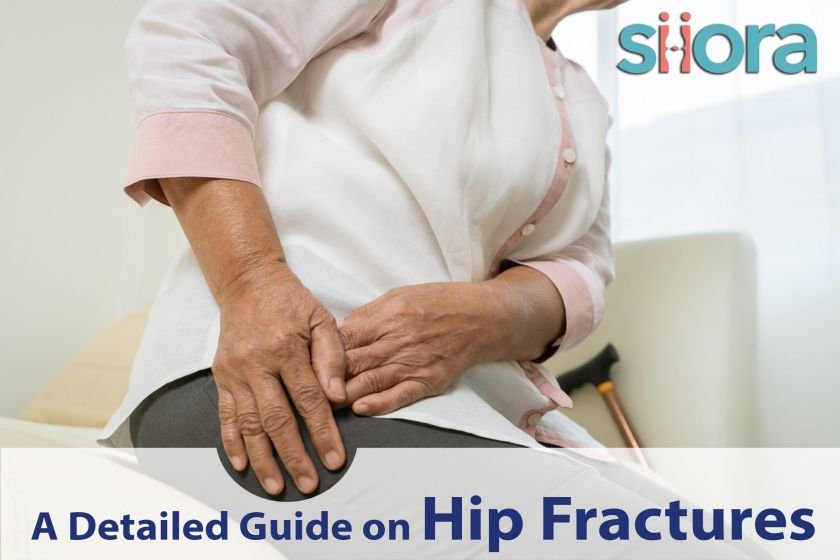What is a Hip Fracture?
A hip fracture is a term given to a condition in which the upper part of the femur breaks. Immediate pain in the hip is experienced when the femoral head breaks. Hip fractures generally occur when some falls and they are common in the elderly. This is because the bones of old aged people are weak and brittle and as a result, even a minor fall can cause a break. In this article, we will take a detailed look at hip fractures along with their causes, symptoms, diagnosis, and treatment. Before going ahead, let us see a brief look at the anatomy of the hip joint.
Anatomy of Hip Joint
One of the two ball and socket type joints in our body is the hip joint. It is a type of synovial joint that helps us perform various body movements like walking, running, sitting, and standing. The articulation of the pelvis with the femur gives rise to the hip joint. The femoral head serves as “the ball” whereas the pelvic acetabulum, a cup-like depression forms “the socket” in which the ball fits.
The hip joint is known to have a good weight-bearing ability and that’s how it provides support to the upper body while doing various activities.
Articular cartilage covers the acetabulum and the femoral head of the joint. The covering is thick at weight-bearing positions. Scientifically, the hip joint is known as the acetabulofemoral joint.

What Happens in Hip Fractures?
Hip fractures occur when the ball portion of the joint breaks. In other terms, we can say a break in the femoral head is known as a hip fracture. It is a painful condition, and the intensity of the pain depends on the cause and its severity. People experiencing hip fractures find it difficult to move, and when they try to, severe pain occurs. In some cases, the affected person may find the injured side of the leg shorter than another. The common signs and symptoms of hip fractures may include:
- Severe pain in the hip
- Swelling around the hip joint
- Inability to walk or pain while walking
- Shortening of leg
- Bruising around the hip joint
- Outward turning of the leg
What Are the Risk Factors for Hip Fractures?
Besides the obvious causes of hip fractures, certain risk factors increase the chances of the condition. Let us see what could make you more prone to hip fractures:
- People suffering from osteoporosis are at high risk of hip fractures. Osteoporosis is a condition that makes bones weak and brittle. Thus, people suffering from the same can get hip fractures because of minor trauma.
- Elderlies have weak and brittle bones and as a result, joint fractures can occur because of a minor fall or lifting heavy weight.
- People who abuse alcohol and smoke are also in the category of high-risk for hip fractures.
- Certain medicines also cause weakness in bones and as a result, fractures can occur easily.
- People suffering from metastatic cancer, dementia, and Parkinson’s disease can also experience fractures in their hips.
Above all, certain lifestyle factors also contribute to making people prone to hip fractures. Those who consume fast food too often, people with a sedentary lifestyle, and obesity are the reasons that increase the risk of hip fractures.
What Are the Different Types of Hip Fractures?
Two of the most common types of hip fractures include:
Femoral Neck Fracture
This is the type of fracture in which the part just below the femoral head i.e., the ball breaks. This area of the femur is called the neck and the fractures occurring in this region are known as femoral neck fractures.
Intertrochanteric Fractures
Intertrochanteric fractures are specific types of hip fractures where the break occurs between the femoral head and the long part of the femur. The bony protrusions present below the femoral head breaks in the case of intertrochanteric fractures.
What Causes Hip Fractures?
High-energy trauma in younger adults is the commonest cause of hip joint fractures, and it may include car/bike accidents or falling from a significant height. Besides this, sportspeople can also experience hip fractures because of contact sports injuries like high-intensity collisions between players while walking.
If we talk about the elderly, then they can get hip fractures because of falls in the home, bathroom, or from stairs. Weaker and brittle bones in old-aged people make them highly prone to hip fractures when compared to adults.
Osteoporotic people can experience hip fractures just by twisting their legs while standing.
How to Prevent Hip Fractures?
A little bit of extra care and maintaining the nutritional balance of the body can help us prevent hip fractures.
Here are the tips and tricks for preventing the fractures. strengthening bones can significantly minimize the chances of fractures in the hip:
Take calcium-rich diet
Calcium is the essential component of our bones and its deficiency can make us highly prone to different types of fractures including hip fractures. So, it is important to have a diet rich in calcium. Besides this, also focus on maintaining vitamin D levels in the body. Always remember, without ‘D’, your body will not utilize calcium as it should.
Be regular with exercises
Bone and muscle strengthening exercises play a vital role in maintaining the strength and flexibility of joints. Thus, exercising should be a part of the daily routine as it also helps maintain body balance. This helps reduce the chances of falls.
Say no to alcohol and cigarettes
Smoking and alcohol abuse are the biggest foes of bones. They cause the depletion of bones and significantly increase the risk of osteoporosis. This also adds to the high chance of the condition.
Activate your sixth sense
When it comes to fractures in the elderly, they often occur in and around the home. So, it is important to prepare your home safe for your parents and grandparents. What you can do here is:
- Keep electrical cords against the walls
- Avoid placing throw rugs if not required
- Keep enough space in the dining area for easy movement
- Keep your home clutter-free
- Keep the bathroom dry after the use
Drive safe
In adults, high-intensity accidents are among the common hip fracture causes. So, drive slowly and safely.
Seek timely help from a professional
If you experience dizziness, body ache, body imbalance, or anything that could cause falls, immediately consult a specialist, and take rest until you feel well.
What is the Diagnosis of Hip Fractures?
The diagnosis of fractures requires a thorough physical examination followed by several imaging tests. At first, the orthopedic specialist will ask you about the symptoms and assess your hip joint physically. Here, he will check the abnormal positioning of your hip joint along with swelling and bruising around the joint. If you can, the doctor will check your gait before moving ahead with the diagnosis. After assessing all these factors, he will decide on imaging tests that can confirm the fracture and its severity. The tests ordered will include:
X-Ray Examination
X-ray reports can confirm the fracture along with its exact location. Now, if an x-ray examination depicts nothing, the doctor will suggest an MRI.
Most fractures show on x-ray as in only certain cases, other tests are required to confirm the condition.
Magnetic Resonance Imaging (MRI)
MRI examination uses high-power magnetic waves to form pictures of bones and soft tissues. This helps the orthopedic specialist to diagnose the condition in a much better way. Hairline hip fractures often require an MRI examination.
CT Scan
In severe cases, the doctor will also order a CT scan as the test can produce more detailed images of the hip joint. This helps in identifying the better treatment procedure.
What is the Treatment of Hip Fractures?
The treatment of fractures in the hip joint depends on their severity and location. Although, most cases require surgical intervention and that involves the use of hip implants.
Now, the type of surgery that can correct the fracture depends on the extent of damage to the joint. Here are the options available for hip surgery:
Internal Repair
Mild to moderate cases of hip fractures are treated with the internal repair. This surgical technique involves the use of orthopedic bone screws that are applied to stabilize fractured bone fragments in the joint. In some cases, a metal plate is also used along with the screw to provide better stabilization. People with non-displaced fractures are ideal candidates for this type of surgery.
Total Hip Replacement
As the name suggests, this type of surgery involves the complete removal of the damaged hip joint and the placing of a hip prosthesis. This means, both the femoral head and the socket is replaced with artificial parts. Severe hip fractures that cannot be managed with internal fixation need a complete hip replacement. Healthy adults with no other complications are ideal candidates for this surgery. It has better long-term outcomes and is best for those who live independently.
Partial Hip Replacement
In a partial hip replacement, the surgeon replaces only the upper part of the femur. This surgery is advised when the socket of the hip joint is intact and only the femoral head is damaged. However, partial hip arthroplasty is best in adults who have other hip complications.
What Recovery is Like After a Hip Surgery?
Recovery after the treatment varies according to the type of surgery, the severity of the fracture, and the health condition of the patient.
Elderlies recovering from fractures may take a much longer time when compared to adults. It is also important to follow post-op instructions given by the doctor to prevent any complications after surgery. Besides this, rehabilitation also plays a vital role in ensuring a quick and better recovery.
One must consult a physical therapy specialist as he will suggest exercises that will focus on improving the range of motion and strengthening the joint. Visiting an extended care facility is a must after hip surgery to come back to a daily routine as soon as possible. Not only the recovery but professionals at extended care facilities will also teach the person to perform routine activities safely. If required, they will suggest using a wheelchair or other assistive devices like walkers or canes.







